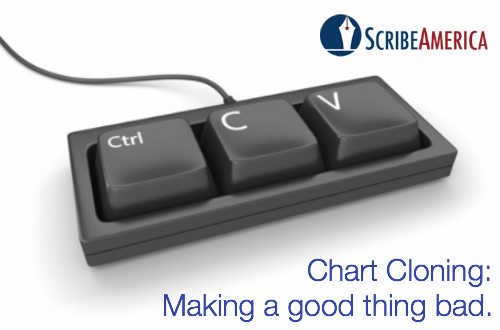If you’ve been using an EHR system for any length of time you’ve probably witnessed or done it yourself, the practice of chart cloning. While chart cloning is technically frowned upon, it has become a popular time saving practice for physicians who are already time strapped and stressed out dealing with complicated EHR systems.
What Is Chart Cloning?
For the uninitiated chart cloning is the nickname for a widely used copy and paste function that’s available in majority of EHR systems being used in the U.S. This copying method allows information to be moved from one medical record to another without having to input the entire data set again.
By cloning charts physicians are able to save themselves huge amounts of time and mental energy. This is especially relevant for when patients need to see multiple specialists over the course of their hospital stay.
Without cloning each specialist would need to fill out the entire chart on their own. But instead they can save hours and energy by cloning the chart already completed by their colleagues and just add any new information they have into the chart. Then that new chart will likely be copied by the next physician attending to the patient, and so on.
The problem with chart cloning
The problem with chart cloning is that technically, every physician who performs a chart clone without actually having done the history and examination that produced the information they’re cloning, is committing fraud.
Fraud is a big word to throw around, but that’s precisely the concern about chart cloning. The federal government considers chart cloning to be a breeding ground for potential billing fraud, and is seeking to snuff it out. For example this might be copying a chart with a billing code for a more expensive procedure than what was actually done. Often though when that happens it’s accidental rather than malicious. Another example might be copying information from a previous visit may make the current visit appear more complex than it is, which would lead to higher reimbursement for the provider.
Regardless , chart cloning has been in the cross hairs of federal inspectors for several of years now. In 2012 The Office of the Inspector General, a wing of the Department of Health and Human Services, named chart cloning as one of its top 10 management challenges to take on that year. Quickly following their lead some Medicare contractors said they would not reimburse providers who billed with cloned information. Per the Medicare Administrative Contractor called National Government Services in Indiana, “Cloned documentation will be considered misrepresentation of the medical necessity requirement for coverage of service due to the lack of specific individual information for each unique patient…”.
Despite the government’s best efforts, chart cloning continues to happen, with up to 78 percent of physicians in 2013 reporting that they regularly use chart cloning.
The necessity of chart cloning
In a world where the best you can hope for from your new mandated EHR system is that it won’t bankrupt your hospital, chart cloning is a necessary evil for physicians.
While there might be some evidence that chart cloning contributes to overbilling and is technically fraudulent, the practice is only bound to grow. Physicians already lead very stressful lives. Just put yourself in their shoes at the end of a long day:
You’re tired and burned out. All you want to do is finish your paperwork and go home to rest. But you still have a mountain of documentation to take care of. If you can find a shortcut that gets you home to have dinner with your family for the first time all week, what would you do? I would clone those charts.
The downside of chart cloning
Of course it would be negligent to discuss chart cloning without mentioning its downsides. The other side of the chart cloning coin is that if a physician is copying a chart wholesale, then a mistake on that chart quickly becomes cemented and spreads around to every subsequent copy.
A mistake like this could potentially put the life of a patient in danger especially if the mistake is something crucial like a discontinued medication or an allergy. But despite those risks, the time and sanity saving benefits of cloning mean that unless EHR systems become easier to manage, that chart cloning is here to stay.
Combat chart cloning mistakes
In terms of a practical way to combat chart cloning, you can look towards the implementation of an assistant taking on the full responsibility for documenting patient-doctor interactions, doctors are freed from the burden of EHR data entry. Meaning they do not have to choose between the easier option of chart cloning, or spending an extra few hours at the end of every shift copying charts by hand.
Perhaps if the federal government is mandating complicated EHR systems, but forbidding time saving measures like chart cloning, a solution might be for them to attempt to simplify the reimbursement system or, if it is not possible to streamline this procedure, at least encourage alternatives to cloning, such as personnel specifically trained to enter the data for the physician.



